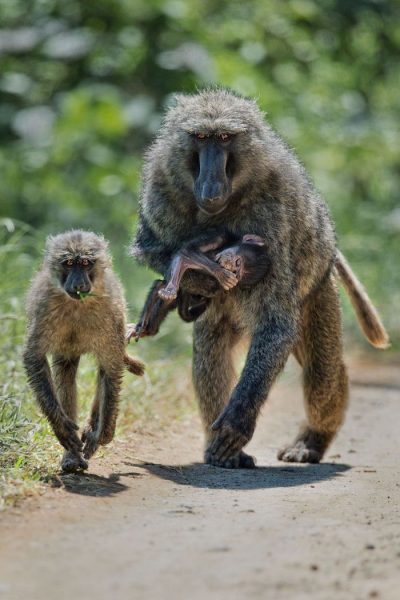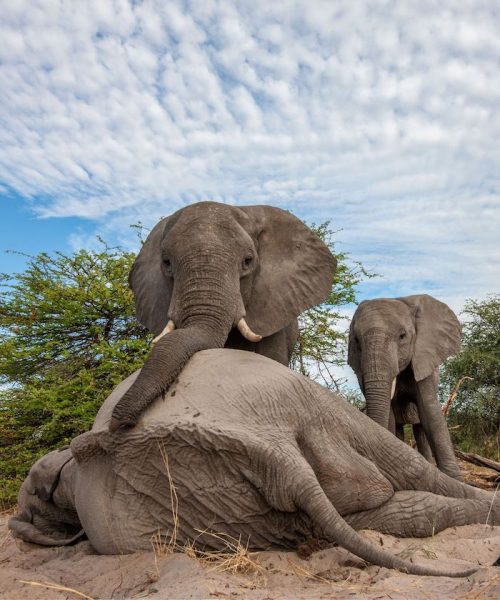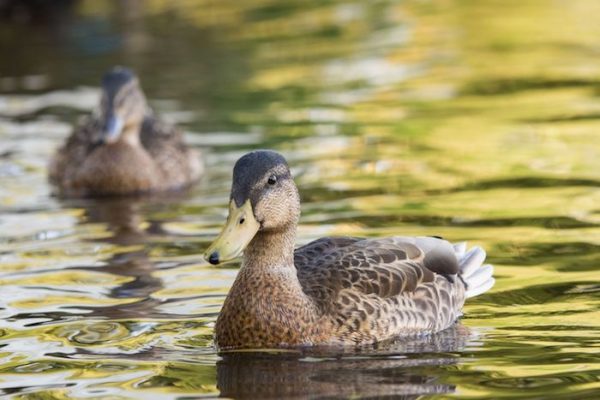[A]mong animal lovers, the urge to anthropomorphize our four-legged, furry, scaly, and/or winged friends is strong. We tell ourselves that dogs like hugs and that cats actually have a sense of loyalty, despite Science refuting both of these rose-tinted hopes. One area of animal behavior in which research gets even more complicated is grief.
Studies have long suggested that certain mammals may recognize and understand death on near-human levels. Elephants and primates, most notably, have been observed mourning and performing what scientists refer to as “death rituals.” That said, these same scientists are reluctant to refer to any non-human species’ response to death as “grieving” just yet. And despite the heartbreaking viral images of chimpanzee funerals, more research needs to be done on animals’ emotions before we draw any conclusions.
Of course, none of this lessens the emotional impact of what we’ve seen so far, whether it’s a mother giraffe licking her dead calf’s body or a baboon seeking comfort with the rest of her group after the death of her daughter. Because the thing is, even among humans, grief can feel like a mystery, so it’s a small comfort to see some of our own mourning processes reflected in other species.
Chimpanzees

Footage of chimpanzees mourning and even holding funerals for their deceased peers abounds. These viral moments are often used as the best proof we have that the apes grieve — but a 2010 study revealed just how profoundly death can affect a community of chimps.
The study focused on the death of an elderly female chimp known as Pansy. The researchers noticed that Pansy’s daughter and another female chimp stayed by her side and groomed her until she died. A male chimpanzee, Chippy, charged Pansy’s body multiple times before she was removed in what researchers viewed as a “final effort to elicit a sign of life,” perhaps out of “some kind of anger about the loss of an important member of the group.”
That night, Pansy’s daughter was observed shifting in her sleep a dozen times (far above the average). When the keepers took Pansy’s body away, the rest of the chimps appeared “profoundly subdued” and exhibited near-human signs of grief in the following weeks, namely having less of an appetite and avoiding the area where Pansy died.
Whales
 Seven different species of whales have been seen staying with their dead and even taking their bodies with them. Researchers believe these may be specific cases of mothers grieving the loss of their young.
Seven different species of whales have been seen staying with their dead and even taking their bodies with them. Researchers believe these may be specific cases of mothers grieving the loss of their young.
For example, a bottlenose dolphin was found pushing another dolphin’s body through the water as it swam. The deceased dolphin was visibly rotting, and yet, when scientists in a nearby boat started to pull the body on board, the dolphin swam after it, staying near the shore after the boat came aground.
Killer whales and pilot whales were also observed carrying dead calves to keep them above water and pushing them toward boats. Other than mourning, scientists haven’t been able to find an explanation for this behavior.
Baboons

Much like humans, baboons’ stress hormones increase production in response to grief. Research from the University of Pennsylvania shows that that isn’t where the resemblance ends. In order to reduce those feelings of stress, baboons will seek out friends for comfort.
After the death of her daughter, a notably high-status, queenlike baboon known as Sylvia went to great lengths for social bonding. She was observed spending time with a group of female baboons who were considered of lower status than her — something she’d never do otherwise, reflecting her immense need for support at that time.
The researchers clarified that Sylvia’s behavior isn’t proof that baboons grieve exactly like humans, but it shows that we aren’t the only species that look for friends when we need to cope with stress.
Elephants

Barbara J. King, author of How Animals Grieve, has called elephants “the gold standard of animal-grief research,” citing two long-term projects studying their behavior.
While other species will mourn their own young, elephants come together as a larger community to share their grief. In an article for NPR, King described the emotional display from a group of elephants reacting to the death of one of their matriarchs, Eleanor.
As Eleanor lay dying, another elephant, Grace, came to her side and tried to nudge her to her feet. Grace became “visibly distressed” after Eleanor failed to stand on her own. After Eleanor died, other elephants approached her body. Some appeared merely curious, gazing and prodding at her, but others seemed profoundly upset, rocking over her and refusing to leave her. The elephants that visited Eleanor were from five different families.
Other elephant communities have been filmed seemingly paying their respects to their dead, even several weeks after their peer has died.
Biologist George Wittemyer told National Geographic that, as much as we’ve seen of their so-called death rituals, elephants’ responses to death remains mysterious: “Every time it happens, it’s not the same, but it is striking behavior — not based on survival or necessity, but based on some sort of emotion.”
Giraffes

Research on giraffes’ capacity for grief is nowhere near as extensive as that on elephants or primates, but one extreme demonstration of loss gave rise to the belief that this species should be considered along with other animals that appear to mourn.
In a scene published in the African Journal of Ecology, a mother giraffe was seen standing over her deceased newborn. She spent hours investigating and licking the body, hovering over it with her legs splayed out. According to BBC Nature, this behavior is anything but normal — giraffes will only splay their legs out wide if they’re eating or drinking, and they do not like being alone for extended periods of time.
At the moment, this mother’s display is one of only three documented cases of giraffes recognizing (and reacting to) death. They may not be the “gold standard” for research that elephants are, but it stands to reason that they may understand death more than we believe.
Ducks

This story also comes from Barbara J. King: Two ducks that were rescued from the same foie gras factory bonded rapidly when they were brought to a sanctuary. One of the ducks, Kohl, had been losing the ability to walk and sanctuary staff eventually decided it was best to euthanize him. The other duck, Harper, witnessed Kohl’s death, approached his body, prodded at it, and laid his head down on top of it. He stayed like that for hours.
After Kohl died, Harper was visibly more nervous around people and never seemed to bond with another duck. Two months later, he died.
This strikes us as eerily similar to the so-called “broken heart syndrome” sometimes seen in humans, but there aren’t enough Kohls and Harpers out there to know for sure if this is common among ducks.
Complete Article HERE!
